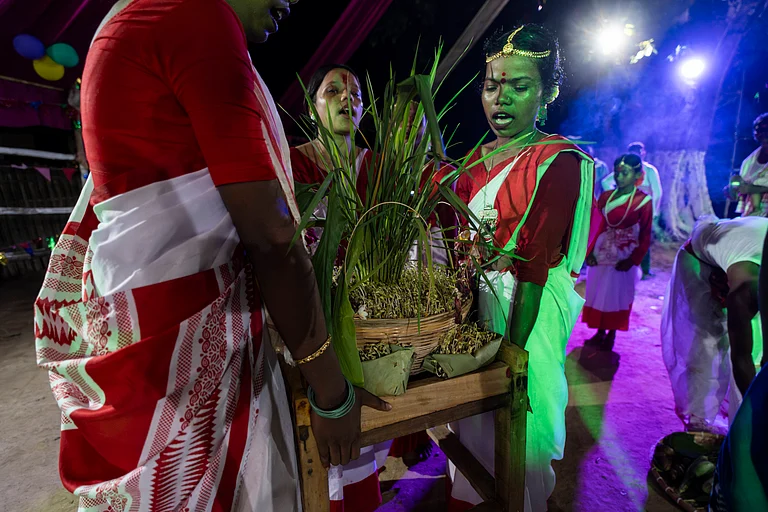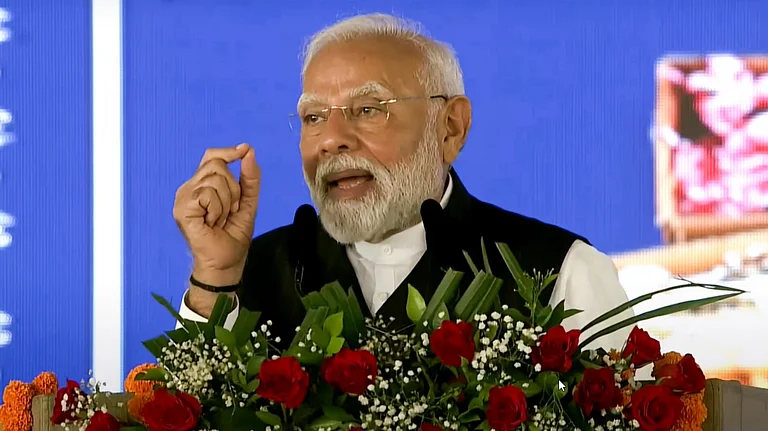(November 15, 2024 marks the 150th birth anniversary of Adivasi leader Birsa Munda, observed now as Janjatiya Gaurav Diwas.)
Between 1895 and 1900, Birsa Munda led the Ulgulan (great tumult) in the Chotanagpur region of present-day Jharkhand, challenging the British Raj and their collaborators, including Christian missionaries and Hindu zamindars. Birsa Munda’s Ulgulan had a dual purpose: to revitalize the Adivasi community, which had been demoralized by colonial domination, and to combat the dikus (both British and indigenous exploiters) while striving for Munda Disum (Munda rule/country). Although Birsa Munda was captured by British forces in February 1900 and subsequently died in Ranchi jail on June 9th, 1900, his rebellion had far-reaching implications for Adivasi's political consciousness and brought about administrative changes in the region. As a result of the movement, the British government enacted the Chotanagpur Tenancy (CNT) Act in 1908, recognizing the customary land rights of the Adivasis in the area. The CNT Act has played a pivotal role in safeguarding the Adivasis against land dispossession and has served as a catalyst for Adivasi mobilization and solidarity during both the colonial and post-colonial periods.
Birsa’s resistance held great importance and inspired subsequent generations of Adivasi leaders to fight for the separate statehood of Jharkhand. However, he remained a relatively obscure figure in the national consciousness until the early decades of independence. It was not until the publication of SP Sinha’s book, “Life and Times of Birsa Munda,” in 1964, and KS Singh’s comprehensive work, “The Dust-Storm and the Hanging Mist: A Study of Birsa Munda and His Movement in Chotanagpur (1874–1901),” in 1966 that Birsa Munda and his movement gained regional and national attention. The publication of Mahasweta Devi’s novel, "Aranyer Adhikar," which won the Sahitya Academy Award in 1977 and was based on Birsa’s life, firmly established his position in the national memory. Concurrently, during this period, the Jharkhand Movement was experiencing a challenging phase. Recognizing the significance of Birsa’s Ulgulan in the public consciousness of the region, the movement’s leaders embraced Birsa as an icon and a symbol of Adivasi strength, representing the ongoing exploitation of Adivasis by external forces, their demand for autonomy and their resilience in resistance.
As the political importance of Birsa increased and political parties recognized the political potency of his elevated position in the collective memory of Adivasis in Jharkhand, it resulted in a phenomenon where every political party began to claim his legacy to align with their own ideologies and gain the support of the Adivasi electorate. This led to a widespread presence of Birsa in the form of images, statues, and memorials, as well as the naming of state buildings, airports, and sports stadiums in Jharkhand and other Adivasi regions. However, this heightened visibility of Birsa and his political significance also resulted in a selective representation of his persona and his movement, depending on the political calculations of the state and political parties. Consequently, a situation has arisen in which Birsa is everywhere, but his political philosophy and the memory of the Ulgulan are often obscured or diluted in order to neutralize the radical potential that his movement and memory embody.
Understanding Birsa’s Ulgulan
To truly comprehend the Ulgulan spearheaded by Birsa Munda, it is essential to consider it within the long history of Adivasi resistance in the Jharkhand region such as the Kol Uprising in 1831-31 and the Santhal Revolt in 1855-56 to name a few. These resistance movements trace their roots back to the consolidation of colonial domination following the permanent settlement of 1793. The settlement introduced the zamindari system, supplanting the previous arrangement between the Adivasis and the Maharaja of Chotanagpur, which recognized their customary land rights and governance practices across most areas.
Unfortunately, the zamindari system brought forth a burdensome taxation regime and bhetbegari (corvee) obligations. Additionally, the massive influx of outsiders, primarily caste Hindus, into the region exacerbated the situation. Consequently, the Adivasis encountered unprecedented levels of land dispossession and socio-political subjugation. The entry of Christian missionaries and the increasing influence of Hinduism further triggered religious churning within Adivasi communities.
These relentless assaults on the Adivasi way of life, coupled with the failure of previously peaceful and legal resistance movements like the Sardari Ladai Movement (1858-1895), which aimed to mitigate the Adivasi predicament through petitions, created a fertile environment for a more forceful and expansive movement led by Birsa Munda. Birsa emerged as a prominent figure spearheading the Ulgulan to counteract the oppressive system. The movement sought to reclaim Adivasi land rights, resist socio-political domination, and safeguard their cultural and religious identity.
Born in 1875 in the village of Ulihatu in the present-day Khunti district of Jharkhand, Birsa Munda belonged to a family that had embraced Christianity due to the influence of German Lutherans in the previous generation. From 1886 to 1890, he attended a German Lutheran Mission School in Chaibasa. However, Birsa’s keen awareness of the socio-political unrest in the region led him to become disillusioned with the Christian faith, prompting him to abandon it. He briefly aligned himself with Anand Panre, a Vaishnavite guru, and was influenced by Vaishnavism, which later played a significant role in his teachings and the way he trained his followers. During the Ulgulan movement, Birsa astutely amalgamated his knowledge from Christianity and Vaishnavism to reframe and reform the Adivasi religious framework, evident in the religious practices of his followers, known as Birsaits.
He recognized that the root cause of the crisis faced by the Adivasis was the alienation of their access and control over Jal (water), Jangal (forest), and Jameen (land) due to the establishment of the British Raj. This alienation was further intensified by exploitative moneylenders and collaborationist zamindars who benefited from the colonial system. Also, Birsa astutely perceived the Janus-faced nature of Christian missionaries. Although they had initially supported the Adivasis in their struggles, he understood that ultimately they aligned themselves with the Raj and refrained from opposing it.
Social Anthropologist Uday Chandra argues that Birsa employed a “politico-theological” approach, combining religious and political practices, to confront the oppressive colonial system represented by British officials, Hindu zamindars, and Christian missionaries. His goal was to mobilize the Adivasis and establish Munda Disum. The deployment of a ‘politico-theological’ approach led many historians and theorists to term the movement as ‘millenarian’ and ‘messianic’.
In 1895, Birsa was initially arrested for spreading radical ideas that opposed the British administration, capturing the attention of the colonial authorities. After serving a two-year jail term, he returned to continue his movement, which began to exhibit more violent tendencies. On the eve of Christmas in 1899, Birsa organized his followers and launched a comprehensive assault on the three pillars of the British Raj: government officials, local zamindars, and missionary workers. Their objective was to establish the glorious rule of the Mundas.
In February 1900, the British government responded with a massive police crackdown, resulting in the capture of Birsa and his associates, and numerous casualties during the police operation. According to oral narratives, the police operation during this period involved the loss of many Adivasi lives, with accounts suggesting that Christian missionaries and Hindu zamindars played significant roles in aiding the police in apprehending Birsa.
Contemporary Tussle Around Memory of Birsa Munda
The Ulgulan, symbolized the Adivasis’ desperate efforts to overthrow the violent structures of the colonial regime that exploited them and devastated their land. In Rahul Ranjan’s recent book ‘The Political Life of Memory: Birsa Munda in Contemporary India’, he argues that the movement “was shaped by accumulated frustrations, denial and loss.”
In contemporary times, there has been a concerted effort by the Hindutva brigade to highlight the influence of Vaishnavism on Birsa and emphasize his opposition to Christian missionaries. This is done in order to fit him into the pantheon of nationalist leaders who fought against British colonial rule. However, such attempts at appropriation present a selective and distorted memory of Birsa and his Ulgulan. They overlook his antagonism towards Hindu landlords and moneylenders, as well as his attacks on temples controlled by the Maharaja.
Regional political parties have also sought to capitalize on the political currency associated with aligning Birsa with an anti-colonial and nationalist narrative. However, this hyper visibility of Birsa has come at the cost of diluting the complex historical scenario that propelled him as a leader. The selective representation of Birsa’s biography and the history of the Ulgulan movement has created a dominant narrative that portrays him solely as an anti-colonial nationalist hero.
It is important to acknowledge that the Adivasi mobilizations against land grabs, displacement, and ongoing violence faced by Adivasis provide an alternative perspective for remembering and drawing inspiration from Birsa. They seek to highlight the continued marginalization and exploitation of Adivasis, issues against which Birsa sacrificed his life. In order to truly understand Birsa’s legacy, it is crucial to recognize the multifaceted aspects of his struggle and the broader context of Adivasi's resistance against the alienation of Jal, Jangal, and Jameen. This perspective sheds light on the ongoing challenges faced by Adivasis and their fight for justice and empowerment, carrying forward Birsa’s vision and mission.
As we remember and pay tribute to Birsa on his death anniversary on June 9th, it is vital to bear in mind the enduring presence of external forces of domination and exploitation that have inflicted harm upon the Adivasi communities and their lands – the very forces that Birsa courageously rebelled against. These forces in their transformed avatar continue to ravage Adivasi's life and land. It is crucial that we reclaim Birsa’s narrative from the clutches of dominant groups and state interpretations, in order to truly honour his memory and draw inspiration to combat the ongoing assault on the Adivasi lifeworld.

























